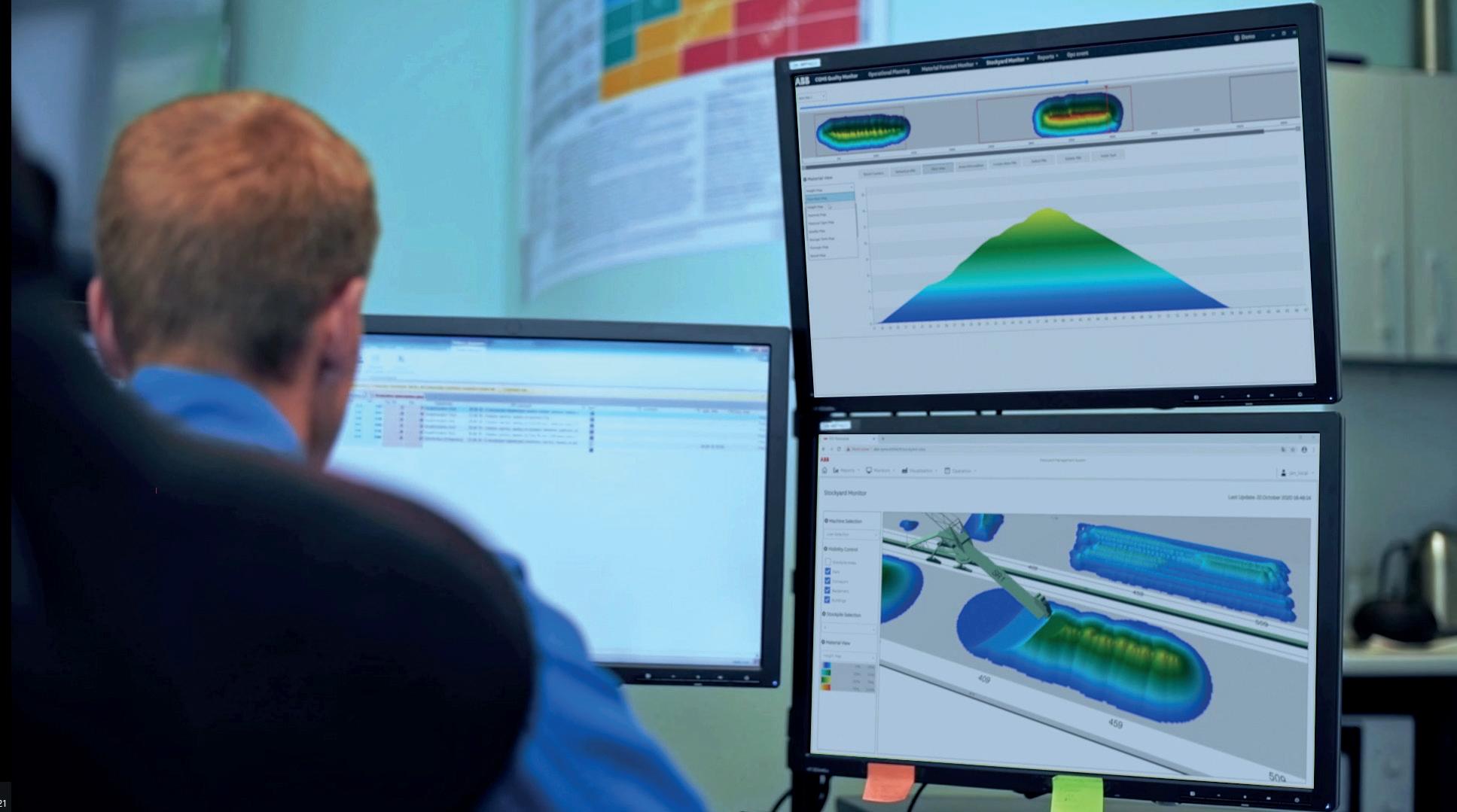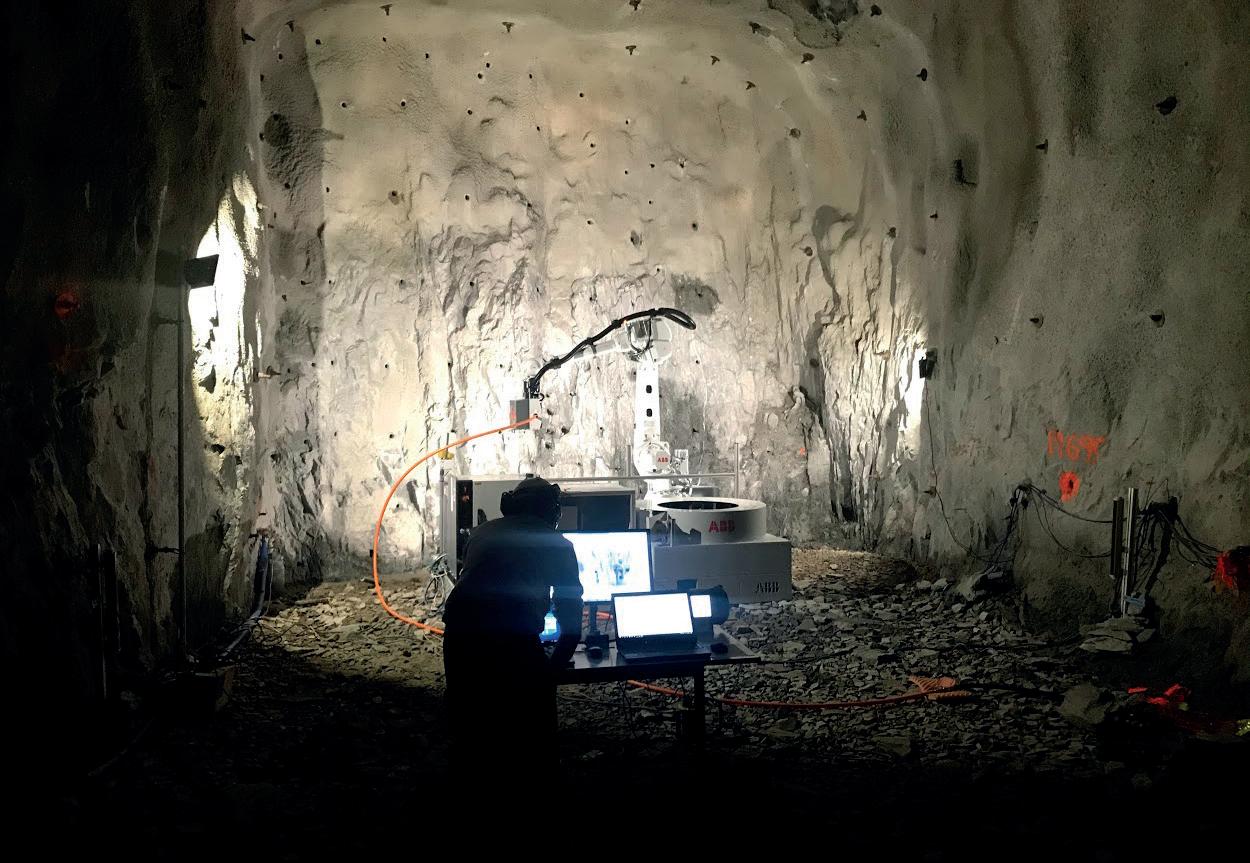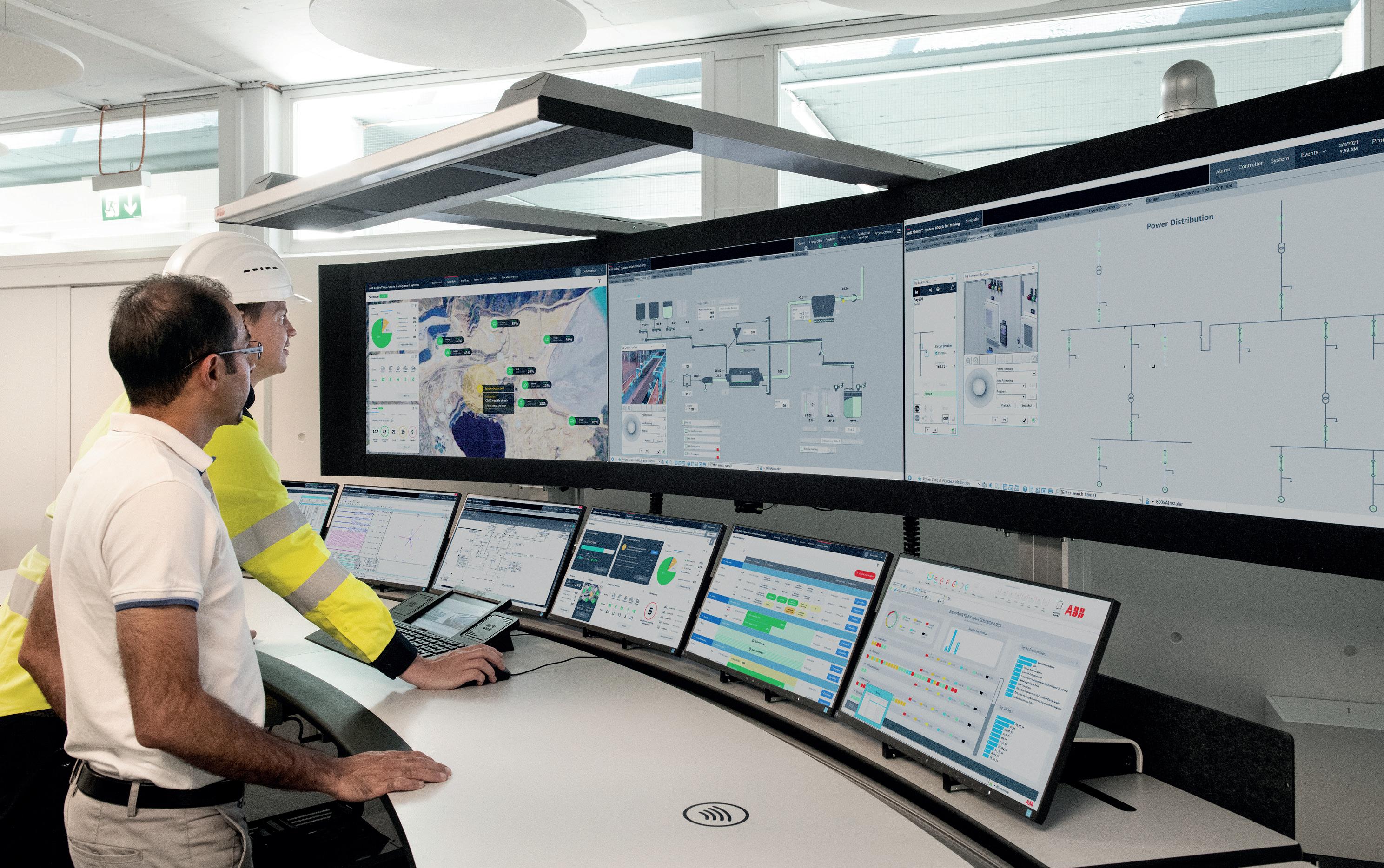
9 minute read
Future-Proofing Operations Using Automation
Marcos Hillal, ABB, Brazil, explains how increased automation equals more efficient and sustainable mine operations.
Mining is undergoing a radical transformation, driven primarily by two disruptive trends: the Fourth Industrial Revolution, or Industry 4.0, and sustainability. Both are pushing the boundaries of what was once thought possible in the extractive industries towards a different way of operating.
To these challenges, the perennial need to maintain throughput and strict quality control during high-volume production can be added. In addition, the quality of ore grades is declining, and reserves are harder to identify and develop, forcing operators to go deeper for longer. These factors directly impact OPEX and the ability of mining companies to remain competitive in the commodities markets.
Automating the OT layer

Against this backdrop, digitalisation is not a luxury, it is a matter of survival. However, it could be argued that real digital transformation does not start with artificial intelligence (AI) and data analytics applications, but instead works from the bottom up, beginning with a stable sensing layer (level 1) with good instrumentation and sensing devices designed to send online information to the operational technology (OT) layer.
At the OT layer (level 2), it is important to avoid having disparate control systems based on programmable logic controllers (PLCs) and SCADA systems which, instead of promoting integration of information, result in operational silos.
The correct approach is to install a distributed control system (DCS), such as ABB AbilityTM System 800xA, to serve as a powerful OT integration platform that connects the multiple automation streams and consolidates data. In this way, the DCS provides an integrated process and power control environment in which to control the plant in a safe and productive way, promoting collaboration and avoiding ‘islands’ of automation.
Data can then flow seamlessly to upper levels to be consumed by production management solutions and process optimisation, based on advanced on-premises solutions such as ABB Ability Operations Management System and ABB Ability Genix Industrial Analytics and AI Suite.
Having a single DCS system handling plant operation also offers benefits in terms of control room consolidation. Today, several plants operate with multiple control rooms on site, which often use different technologies and platforms to perform a variety of key tasks, such as: process and power automation, asset condition monitoring, and visualisation of the facility using CCTV cameras. This is counter-intuitive to promoting collaboration and providing an attractive workplace environment that appeals to the new generation of talent. For this reason, ABB not only invests in new ways of operating, such as VCO graphics, but also in properly designing the layout of control rooms so that they are fit for purpose when it comes to operating a critical industrial asset 24/7.
The role of digital twins
A digital twin can be described as a virtual counterpart of a real-life physical object or process in real time. In the context of the mining sector, digital twins can be used for everything from material and quality tracking to asset inventory monitoring – in other words, they can address the whole value chain from mine to port or market, and in a variety of underground and surface mining scenarios.
An example of the usage of digital twin concept is ABB Ability Stockyard Management System, which enables real-time supervision, planning, automated reporting and simulation of bulk stockyards, and in doing so opens the door to fully automated and autonomous operations.
ABB’s Stockyard Management System digitises, monitors, optimises, and automates material handling operations. This gives mining operators a higher level of situational awareness around their shift or whole cycle operation, predominantly by knowing exactly the material buffer status in terms of utilisation, available quantities and qualities, as well as potential blending or ready-for-shipping capacities.
In addition, the system is a job scheduling, reporting and forecasting tool, and can include full-site automation for major handling machinery; for example, stacker-reclaimers and conveyor lines.
Case study: Germany
ABB recently concluded two successful projects using its Stockyard Management System. The first was for a German steelmaker seeking a quick digital solution for material batch planning and quarterly yard inventory validation.
Using ABB’s system, the customer has a much higher degree of transparency regarding the current buffer status, resulting in optimisation of material sourcing and trading, and overall production planning.
Case study: Serbia
In Serbia, ABB's solution is deployed for continuous quantity and quality monitoring at two mines that feed a mill and train loading station, using a single overland conveyor system. Here, ABB's Ability Stockyard Management System not only prevents the mill from receiving waste material, but also enables the train
loader to distribute the material in intended quality ranges. Moreover, the shift supervisor and excavator operators receive constant real-time feedback on material quality and alerts that help them to match the shift goals.
In summary, the main driver of potential cost savings from the solution is the exact knowledge regarding material composition inside the buffer or stockyard. On top of that, the scheduling and execution of all resulting material handling operations are more precise and well timed and, in general, depending on the use case, cost savings of 5 – 10% are possible thanks to machinery being fully automated.
Remote possibilities: robot charger technology
Removing personnel from potentially hazardous subterranean environments has become a strategic priority for mining operators, and automated technologies are again the key to making this happen.
Ore bodies contain metals that are typically embedded within large mineral blocks. Therefore, the first step of the mining process normally involves blasting the targeted exploration bench to reach smaller piece of rocks, which are then crushed and grinded still further into even smaller particles to allow further chemical process treatments to be carried out to extract the final metal.
This process is typically carried out manually, with an operator assembling the detonator and primer, and connecting ignition cords to trigger the detonation, the latter being done locally or remotely.
ABB’s remote charger robot automates one of few manual processes left in mining by detecting boreholes and then filling them with explosives and detonators without the need for human intervention. The technology constitutes a significant step forward in mine safety.
The robot uses a vision system to locate all drilled holes on the face within the scanning area and then calculates how many of them are possible to reach and charge. Next, the system begins the charging operation of the first hole by extracting a detonator cassette from the detonator magazine. The detonator is joined to the primer, flipped around, and attached to the end of the charging hose.
The charging head is then moved to the position of the first hole and the charging hose is pushed inside the bottom of the drilled hole. Explosives are then pumped through the hose while retracted.
This remote charger technology development project was part of SIMS, an EU led initiative that spanned from 2017 – 2020, and explored joint activities aimed at creating Sustainable Intelligent Mining Systems.
Prototyping and testing in a real underground environment at Boliden’s Garpenberg mine in Sweden was carried out at the end of 2019. Work is still ongoing to improve the robustness of the solution and adapt it for real-life operations, with the aim of developing a fully-functional prototype capable of running as part of a real-life mine – improving not only safety, but also, potentially, productivity.

Figure 1. ABB AbilityTM Stockyard Management System provides exact knowledge regarding material composition inside the buffer or stockyard.

Figure 2. ABB’s remote charger robot automates one of few manual processes left in mining.
The future is electric
The all-electric mines of the future will be smart and sustainable, but innovations such as hybrid trucks connected to trolley lines and battery electric vehicles, both designed to reduce emissions from heavily polluting diesel engines, require additional supplies of reliable, on-demand power.
In response, ABB has developed the pilot ABB Ability eMine FastCharge – which will be part of the new ABB Ability eMine portfolio. ABB Ability eMine FastCharge – currently in the pilot phase – is set to become the world’s fastest and only fully automated charging system for mining haul trucks, offering up to 600 kW of power for more efficient, sustainable, and safe operations in underground and opencast mines.
Ramping up the speed and efficiency of the power supply keeps vehicle downtime during charging to a minimum, thus maximising the process productivity.
In addition, the ability to pump significantly larger amounts of energy into the vehicle battery in a shorter timeframe means that operators can incorporate charging into their existing working cycles, in addition to leveraging the natural, process-imposed downtime of the BEV, and charging off-cycle.
Integration and visualisation
These new power requirements also call for a comprehensive integration between plant operation and electric control. ABB Ability System 800xA is therefore evolving to meet the demands of an ever-changing market. One of ABB Ability System 800xA’s flexible I/O solutions is the recently launched xStream Engineering, which helps companies to reduce project time by ‘de-coupling’ automation tasks – such as
field installation and testing; and application programming – from each other. This reduces testing and people requirements and minimises the impact of late changes.
Application engineering can now be performed in parallel with the installation and configuration of the hardware using ‘signals’, a new Control Builder (a System 800xA engineering tool) concept that effectively decouples the hardware and the application engineering, leading to more efficient and sustainable project implementation, therefore helping to reduce one of the major bottlenecks in automation projects execution.
In the field of operational control, the company recently introduced a new visual control graphic interface to its ABB Ability System 800xA Minerals Process Control Library automation software solution. The new library version, running on top of the new ABB’s DCS version 6.1.1, comes with a new clear and intuitive graphical interface for process displays, faceplates and workplace layout, providing operators with relevant process information in its situational context, as well as better awareness of any given situation within the plant. The updated DCS also offers an extensive set of options for adapting presentation, so that the focus can be tailored and users can navigate to the required information much faster.
A new, unique alarm system enables operators to detect, understand, and resolve various types of process situations and disturbances in minimum time. The most critical elements of the production process are emphasised through a combination of context-based information and consistent alarm colours and shapes, ensuring that attention is always drawn to those requiring immediate response.

Figure 3. ABB Ability System 800xA Minerals Process Control Library automation software solution supports greater visualisation.
Conclusion
Industry 4.0 and sustainability are two trends that will continue to drive innovation in mining and demand a collaborative approach. A partnership between a trusted technology partner with proven domain experience and mine operator is key to embracing new technologies that optimise productivity, sustainability, and, ultimately, profitability.
Nobody can predict what the future will look like, but one thing is for sure: the journey towards the all-electric, digitalised and sustainable mine is on the way, and the increased automation and electrification that comes with it is happening. There is no turning back.
Roadmap











